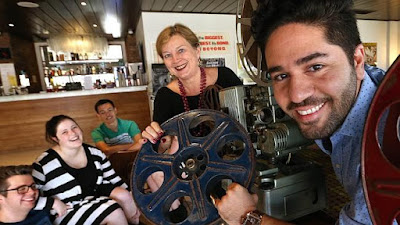 |
| Sadegh Tirafkan (Iranian, 1965–2013). Multitude 10, 2008. Digital photo collage, lambda print; H. 29 1/8 in. (74 cm), W. 44 1/8 in. (112 cm). The Metropolitan Museum of Art, New York, Purchase, 2011 NoRuz at the Met Benefit, 2013 (2013.258). Courtesy Met Museum. |
Though the vast majority of the Met's Islamic collection comprises historical artifacts, we have recently started collecting contemporary art from the regions represented in our galleries. Deciding what exactly is included in the field of contemporary Islamic art is an issue that has been heatedly debated in past years, including most recently at a conference, Contemporary Islamic Art, Design, and Architecture 2015, that I attended in Singapore just a few weeks ago. Scholars have differing opinions of how to define or label works from this category, and our department takes its own particular approach. For us, the collecting mandate is that modern and contemporary works must relate to the historical collection.
A popular theme for some contemporary Iranian artists is to use iconography that refers to the Persian national epic, the Shahnama (Book of Kings), originally composed by Abu'l Qasim Firdausi (935–1020). In the work above, Rustam Returns at Age 30 after Being Brought Up Abroad, Iranian artist Siamak Filizadeh uses new media and popular culture to reference the hero Rustam. This same character appears in illustrations found in various manuscripts of the Shahnama, including the famous sixteenth-century version created for Shah Tahmasp.
Identifiable by his leopard-skin helmet in both the historical and the contemporary depictions, artists have usually portrayed Rustam in a manner that highlights his bravery and strength. In Filizadeh's work, he represents Rustam the hero as a muscular bodybuilder, with the letter "R" covering a red-and-yellow Superman logo on his bare chest. Here, he holds a rocket-propelled grenade launcher with a small decal of the film character Rambo and wears a Dolce and Gabbana belt. Contemporary Rustam appears with a tiled Safavid-style arch and rocks akin to those found in Persian miniature painting, as well as the Shahyad monument (Burj-i Azadi) built in 1971, considered to be the quintessential symbol of and gateway to modern Tehran. The work is a whimsical creation of an immediately identifiable character and uses visual cues to bridge chronology between historical and contemporary Islamic art.
Meanwhile, in Sadegh Tirafkan's Multitude 10, the artist creates a digital photo collage of young Iranian girls performing exercises in a gym class.







